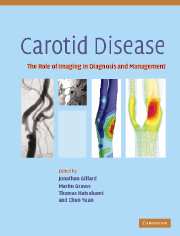Book contents
- Frontmatter
- Contents
- List of contributors
- List of abbreviations
- Introduction
- Background
- Luminal imaging techniques
- Morphological plaque imaging
- Functional plaque imaging
- Plaque modelling
- Monitoring the local and distal effects of carotid interventions
- Monitoring pharmaceutical interventions
- 30 Vascular imaging and the clinical development of new pharmaceuticals
- 31 Monitoring pharmaceutical interventions with conventional ultrasound (IMT)
- 32 Monitoring pharmaceutical interventions with IVUS
- 33 Monitoring of pharmaceutical interventions: MR plaque imaging
- Future directions in carotid plaque imaging
- Index
- References
33 - Monitoring of pharmaceutical interventions: MR plaque imaging
from Monitoring pharmaceutical interventions
Published online by Cambridge University Press: 03 December 2009
- Frontmatter
- Contents
- List of contributors
- List of abbreviations
- Introduction
- Background
- Luminal imaging techniques
- Morphological plaque imaging
- Functional plaque imaging
- Plaque modelling
- Monitoring the local and distal effects of carotid interventions
- Monitoring pharmaceutical interventions
- 30 Vascular imaging and the clinical development of new pharmaceuticals
- 31 Monitoring pharmaceutical interventions with conventional ultrasound (IMT)
- 32 Monitoring pharmaceutical interventions with IVUS
- 33 Monitoring of pharmaceutical interventions: MR plaque imaging
- Future directions in carotid plaque imaging
- Index
- References
Summary
Cardiovascular disease is the leading cause of death worldwide (World Health Organization, 2004). The majority of cardiovascular disease complications are atherosclerosis related (Lusis, 2000), and the discovery of novel forms of treatment for atherosclerosis has been a top priority for the pharmaceutical and biotechnology industry. However, the process of assessing clinical efficacy is associated with extraordinary cost, in that trials utilizing clinical endpoints, such as myocardial infarction, stroke, or cardiovascular death, require large study populations followed for many years. Reliable imaging biomarkers of atherosclerosis would potentially yield significant benefits in terms of efficiency and cost-savings in the development of new compounds.
Background and definitions
In 2001, the National Institutes of Health convened an expert working group to provide standardized terminology with regard to biomarkers in clinical trials (2001). The panel defined biological marker (biomarker) as a characteristic that is objectively measured and evaluated as an indicator of normal biological processes, pathogenic processes, or pharmacologic responses to a therapeutic intervention. A clinical endpoint is a characteristic or variable that reflects how a patient feels, functions, or survives. A surrogate endpoint is a biomarker that is intended to substitute for a clinical endpoint. A surrogate endpoint is expected to predict clinical benefit (or harm or lack of benefit or harm) based on epidemiologic, therapeutic, pathophysiologic, or other scientific evidence. Therefore, surrogate endpoints are a subset of the biomarker class, and not all biomarkers fulfill the criteria to be considered a surrogate endpoint.
- Type
- Chapter
- Information
- Carotid DiseaseThe Role of Imaging in Diagnosis and Management, pp. 464 - 470Publisher: Cambridge University PressPrint publication year: 2006



